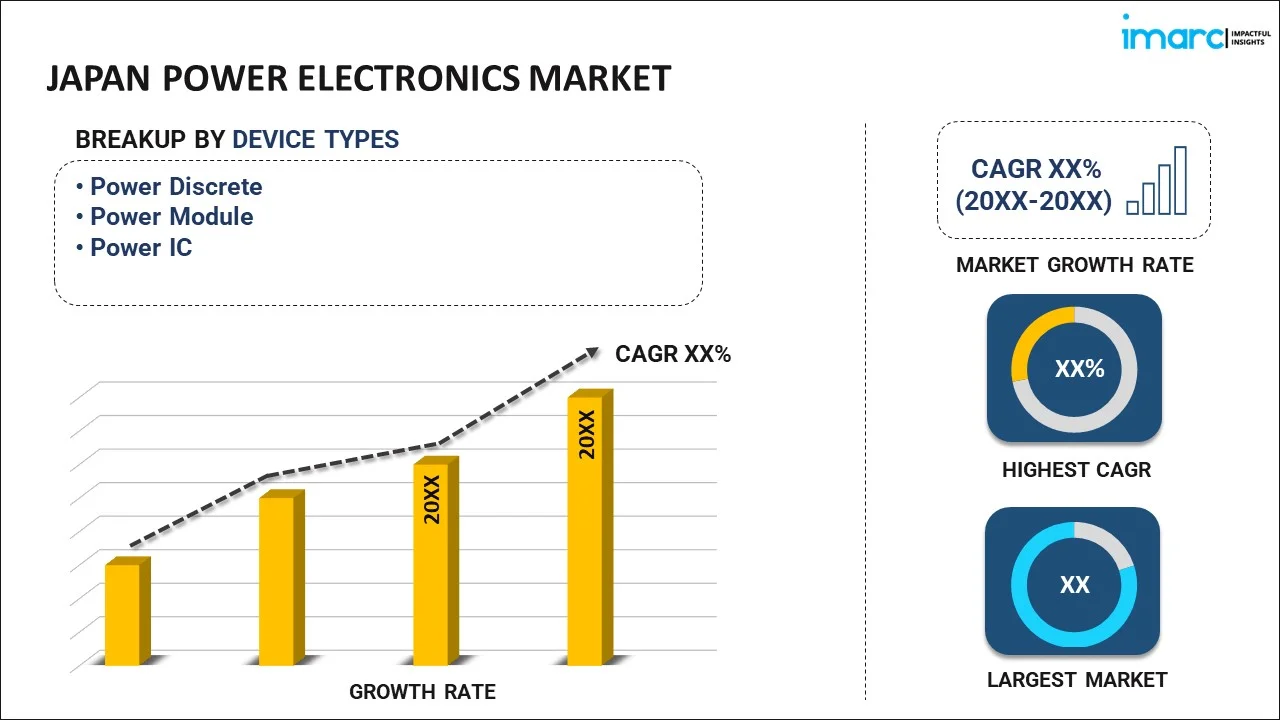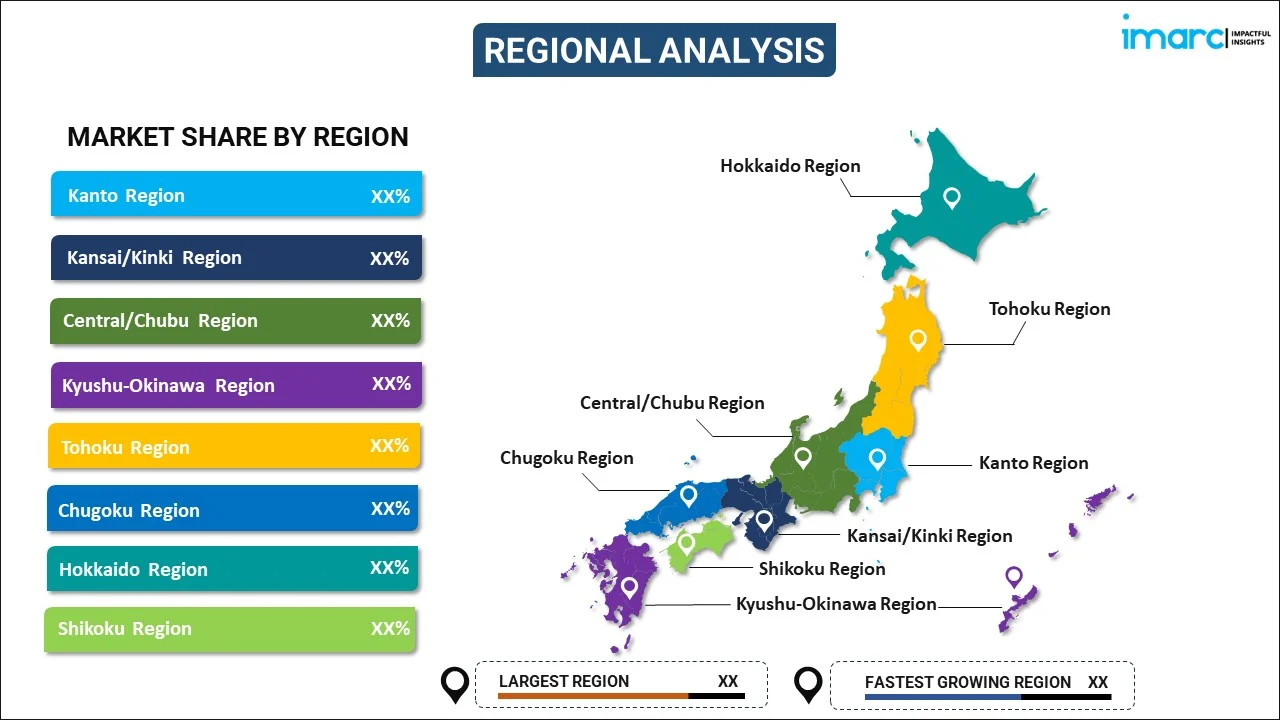
Japan Power Electronics Market Report by Device Type (Power Discrete, Power Module, Power IC), Material (Silicon Carbide, Gallium Nitride, Sapphire, and Others), Application (Power Management, UPS, Renewable, and Others), End User (Telecommunication, Industrial, Automotive, Consumer Electronics, Military and Defense, Energy and Power, and Others), and Region 2025-2033
Market Overview:
Japan power electronics market size reached USD 1,939.5 Million in 2024. Looking forward, IMARC Group expects the market to reach USD 2,952.5 Million by 2033, exhibiting a growth rate (CAGR) of 4.54% during 2025-2033. The escalating adoption of renewable energy sources, such as solar and wind power that requires sophisticated power electronics solutions for efficient energy conversion, grid integration, and energy storage, is primarily driving the market.
|
Report Attribute
|
Key Statistics
|
|---|---|
|
Base Year
|
2024 |
|
Forecast Years
|
2025-2033 |
|
Historical Years
|
2019-2024
|
| Market Size in 2024 | USD 1,939.5 Million |
| Market Forecast in 2033 | USD 2,952.5 Million |
| Market Growth Rate (2025-2033) | 4.54% |
Power electronics is a branch of electrical engineering that deals with the control and conversion of electrical power from one form to another. It involves the use of electronic devices and circuits to efficiently regulate and manipulate electrical energy. Power electronics plays a crucial role in various applications, including renewable energy systems, electric transportation, industrial automation, and consumer electronics. One of its primary functions is the conversion of DC (direct current) to AC (alternating current) and vice versa, which is essential for transmitting electricity over long distances and powering various electronic devices. Power electronic devices like transistors, diodes, and thyristors are used to achieve this conversion process. Furthermore, power electronics are instrumental in voltage regulation, power factor correction, and motor control. It enhances energy efficiency, reduces energy losses, and ensures stable and reliable power distribution. Overall, power electronics is a critical field that underpins modern electrical systems, making it possible to efficiently manage and utilize electrical power in a wide range of applications, from renewable energy generation to everyday consumer electronics.
Japan Power Electronics Market Trends:
The power electronics market in Japan is multifaceted, interconnected, and essential for the industry's growth. To begin with, the increasing demand for energy-efficient solutions has become a prominent catalyst. Energy conservation initiatives and stringent regulations in Japan have compelled industries to adopt power electronics to optimize energy consumption. Furthermore, the proliferation of renewable energy sources, such as solar and wind, has fueled the need for power electronics. These sources produce variable and intermittent power, necessitating advanced power electronics to efficiently convert and manage the generated energy. Moreover, the growing automotive sector has significantly contributed to the surge in power electronics demand. The shift towards electric and hybrid vehicles relies heavily on power electronics for motor control, battery management, and charging infrastructure development. Additionally, the emerging application of consumer electronics, which pushes manufacturers to invest in cutting-edge power electronic technologies to launch faster, smaller, and more energy-efficient devices, is expected to drive the power electronics market in Japan during the forecast period.
Japan Power Electronics Market Segmentation:
IMARC Group provides an analysis of the key trends in each segment of the market, along with forecasts at the country level for 2025-2033. Our report has categorized the market based on device type, material, application, and end user.
Device Type Insights:

- Power Discrete
- Power Module
- Power IC
The report has provided a detailed breakup and analysis of the market based on the device type. This includes power discrete, power module, and power IC.
Material Insights:
- Silicon Carbide
- Gallium Nitride
- Sapphire
- Others
A detailed breakup and analysis of the market based on the material have also been provided in the report. This includes silicon carbide, gallium nitride, sapphire, and others.
Application Insights:
- Power Management
- UPS
- Renewable
- Others
The report has provided a detailed breakup and analysis of the market based on the application. This includes power management, UPS, renewable, and others.
End User Insights:
- Telecommunication
- Industrial
- Automotive
- Consumer Electronics
- Military and Defense
- Energy and Power
- Others
A detailed breakup and analysis of the market based on the end user have also been provided in the report. This includes telecommunication, industrial, automotive, consumer electronics, military and defense, energy and power, and others.
Regional Insights:

- Kanto Region
- Kansai/Kinki Region
- Central/ Chubu Region
- Kyushu-Okinawa Region
- Tohoku Region
- Chugoku Region
- Hokkaido Region
- Shikoku Region
The report has also provided a comprehensive analysis of all the major regional markets, which include Kanto Region, Kansai/Kinki Region, Central/ Chubu Region, Kyushu-Okinawa Region, Tohoku Region, Chugoku Region, Hokkaido Region, and Shikoku Region.
Competitive Landscape:
The market research report has also provided a comprehensive analysis of the competitive landscape. Competitive analysis such as market structure, key player positioning, top winning strategies, competitive dashboard, and company evaluation quadrant has been covered in the report. Also, detailed profiles of all major companies have been provided.
Japan Power Electronics Market Report Coverage:
| Report Features | Details |
|---|---|
| Base Year of the Analysis | 2024 |
| Historical Period | 2019-2024 |
| Forecast Period | 2025-2033 |
| Units | Million USD |
| Scope of the Report | Exploration of Historical and Forecast Trends, Industry Catalysts and Challenges, Segment-Wise Historical and Predictive Market Assessment:
|
| Device Types Covered | Power Discrete, Power Module, Power IC |
| Materials Covered | Silicon Carbide, Gallium Nitride, Sapphire, Others |
| Applications Covered | Power Management, UPS, Renewable, Others |
| End Users Covered | Telecommunication, Industrial, Automotive, Consumer Electronics, Military and Defense, Energy and Power, Others |
| Regions Covered | Kanto Region, Kansai/Kinki Region, Central/ Chubu Region, Kyushu-Okinawa Region, Tohoku Region, Chugoku Region, Hokkaido Region, Shikoku Region |
| Customization Scope | 10% Free Customization |
| Post-Sale Analyst Support | 10-12 Weeks |
| Delivery Format | PDF and Excel through Email (We can also provide the editable version of the report in PPT/Word format on special request) |
Key Questions Answered in This Report:
- How has the Japan power electronics market performed so far and how will it perform in the coming years?
- What has been the impact of COVID-19 on the Japan power electronics market?
- What is the breakup of the Japan power electronics market on the basis of device type?
- What is the breakup of the Japan power electronics market on the basis of material?
- What is the breakup of the Japan power electronics market on the basis of application?
- What is the breakup of the Japan power electronics market on the basis of end user?
- What are the various stages in the value chain of the Japan power electronics market?
- What are the key driving factors and challenges in the Japan power electronics?
- What is the structure of the Japan power electronics market and who are the key players?
- What is the degree of competition in the Japan power electronics market?
Key Benefits for Stakeholders:
- IMARC’s industry report offers a comprehensive quantitative analysis of various market segments, historical and current market trends, market forecasts, and dynamics of the Japan power electronics market from 2019-2033.
- The research report provides the latest information on the market drivers, challenges, and opportunities in the Japan power electronics market.
- Porter's five forces analysis assist stakeholders in assessing the impact of new entrants, competitive rivalry, supplier power, buyer power, and the threat of substitution. It helps stakeholders to analyze the level of competition within the Japan power electronics industry and its attractiveness.
- Competitive landscape allows stakeholders to understand their competitive environment and provides an insight into the current positions of key players in the market.
Need more help?
- Speak to our experienced analysts for insights on the current market scenarios.
- Include additional segments and countries to customize the report as per your requirement.
- Gain an unparalleled competitive advantage in your domain by understanding how to utilize the report and positively impacting your operations and revenue.
- For further assistance, please connect with our analysts.
 Inquire Before Buying
Inquire Before Buying
 Speak to an Analyst
Speak to an Analyst
 Request Brochure
Request Brochure
 Request Customization
Request Customization




.webp)




.webp)












